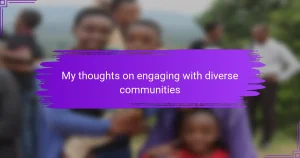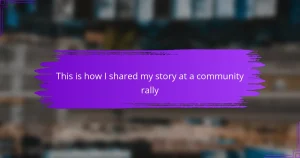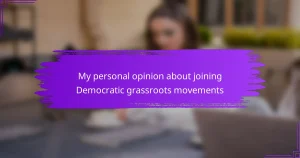Key takeaways
- Bluegrass communities foster collaboration, emotional honesty, and a sense of belonging, creating strong interpersonal connections.
- Core principles of community building include trust, mutual respect, and active participation, emphasizing small acts of kindness over grand gestures.
- Music serves as a unifying force in social movements, helping to bridge gaps and foster empathy among diverse groups.
- Sustaining a music-based community relies on consistent gatherings, nurturing mentorship, and creating inclusive spaces for all members to contribute.
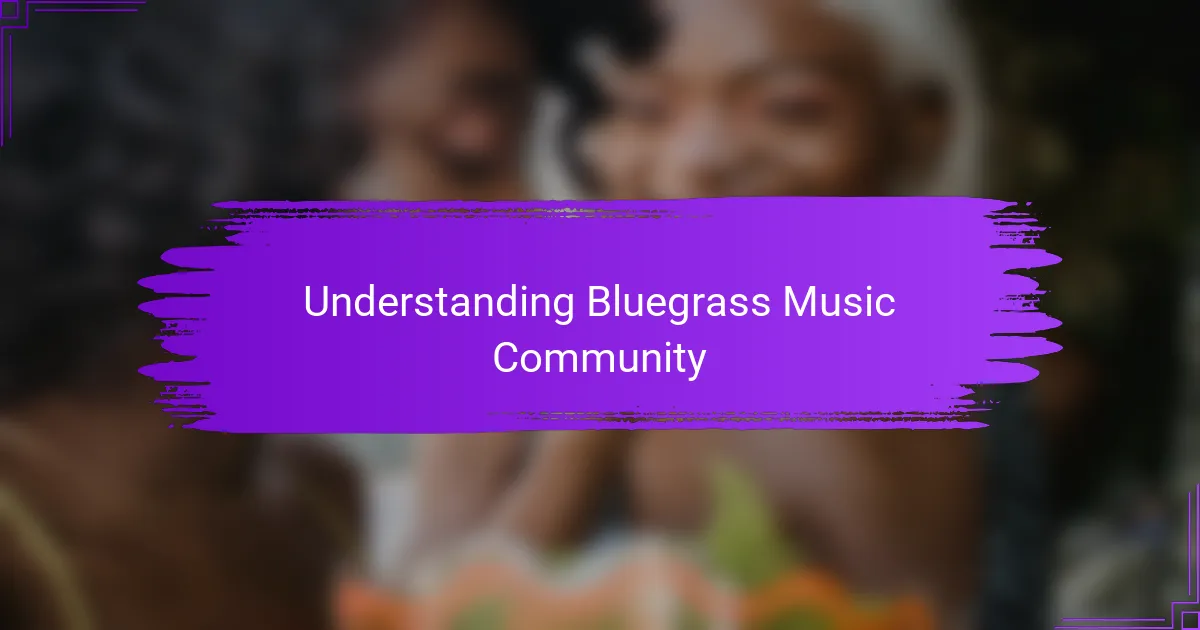
Understanding Bluegrass Music Community
When I first stepped into a bluegrass gathering, I was struck by the immediate warmth and openness of the community. It’s not just about the music; it’s about sharing stories, supporting one another, and creating a space where everyone feels they belong. Have you ever experienced a place where strangers instantly feel like family? That’s what bluegrass does.
What fascinates me about bluegrass communities is their emphasis on collaboration rather than competition. Musicians pass down songs, techniques, and traditions in a way that feels organic and heartfelt. It reminds me of how, in any strong community, knowledge and kindness flow freely from person to person.
There’s also an honesty in bluegrass music that mirrors the community’s spirit. The raw emotions in the songs connect deeply with listeners, fostering genuine bonds. This emotional vulnerability creates trust and unity—qualities essential for building any thriving community.
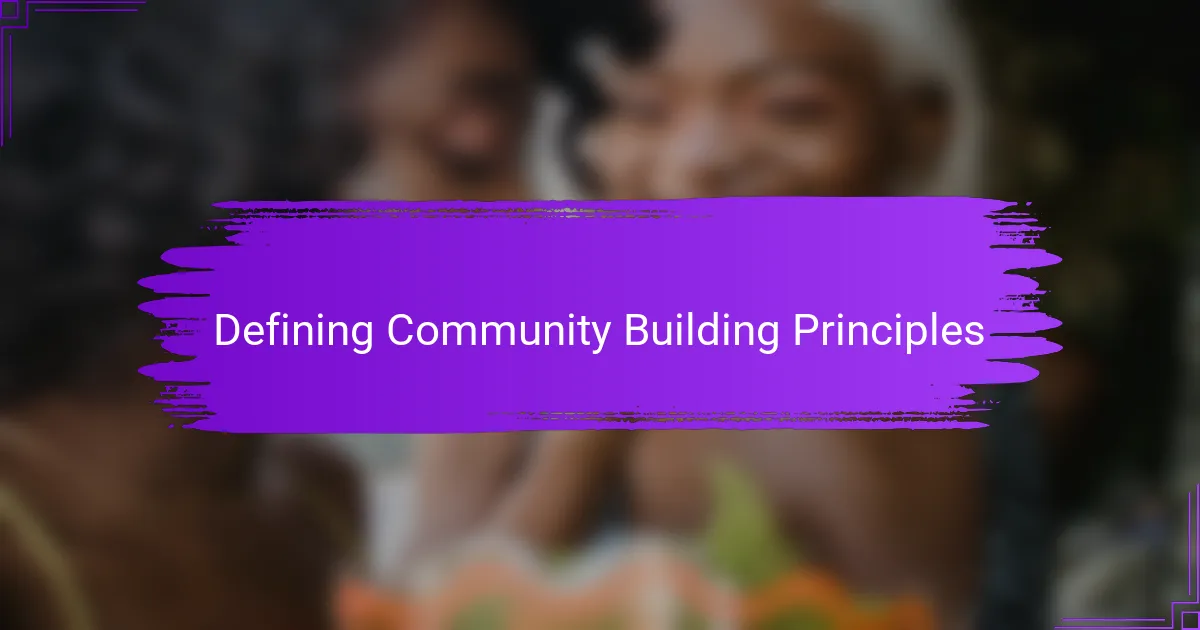
Defining Community Building Principles
What does it really take to build a community that lasts? From my experience, the core principles revolve around trust, mutual respect, and active participation. When people feel valued and heard, they naturally come together, creating a foundation that’s much stronger than any shared interest alone.
I’ve noticed that in bluegrass circles, everyone contributes something, no matter how small. Isn’t that the beauty of genuine community? It’s not about grand gestures but those small, consistent acts that show you care and want to be part of something bigger.
It’s surprisingly simple yet profoundly powerful: consistent support and openness. When I see a group willing to welcome newcomers and embrace differences, I realize they’ve nailed the essence of community building. Don’t we all crave that sense of belonging where we can be ourselves without fear?
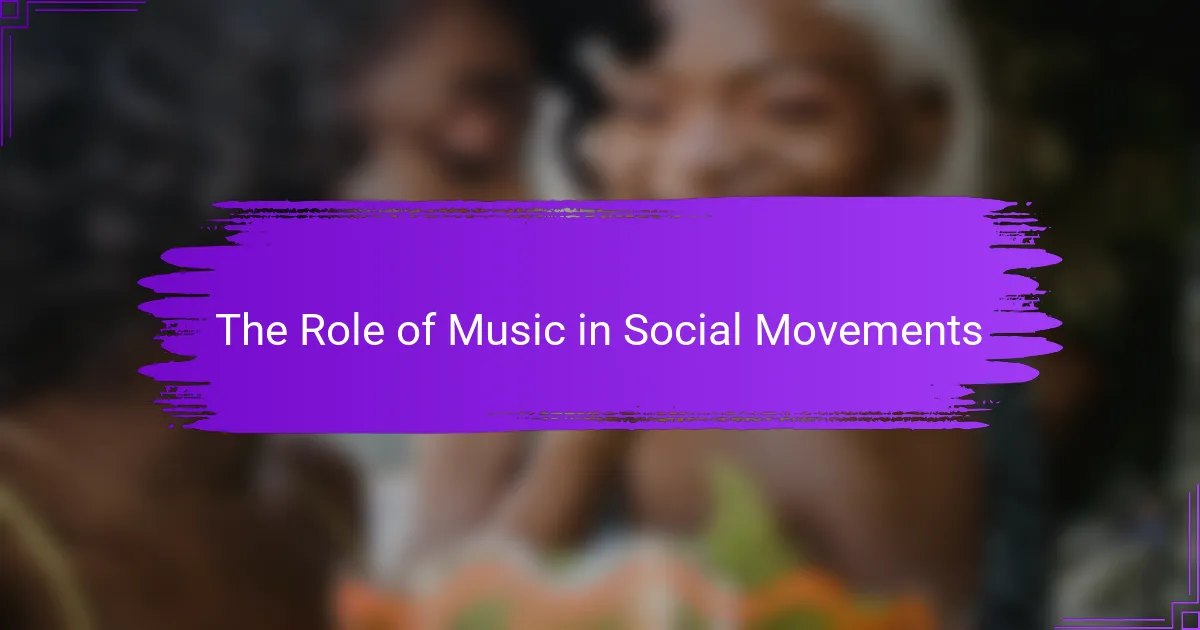
The Role of Music in Social Movements
Music has always been the heartbeat of social movements, acting as a voice for change when words alone don’t seem enough. I remember hearing how songs like “We Shall Overcome” galvanized entire communities during the civil rights era—it’s powerful how melodies can carry hope and resilience. Have you ever thought about why certain songs just stick with us during tough times? They become anthems that unite people around a common cause.
When I think about bluegrass in this context, its storytelling nature makes it a perfect fit for movements seeking authenticity and connection. The way bluegrass musicians share real-life struggles and triumphs in their lyrics reminds me of spoken testimonies that invite empathy and understanding. That kind of emotional honesty can break down barriers and rally people who might otherwise feel isolated.
It’s no surprise to me that music bridges gaps between diverse groups in social causes. Music creates a sacred space where differences fade because everyone’s focused on that shared rhythm or message. Have you ever been at a gathering where everyone was singing together and suddenly, strangers felt like friends? That’s the magic of music fueling social movements—it’s both a unifier and a catalyst for lasting bonds.
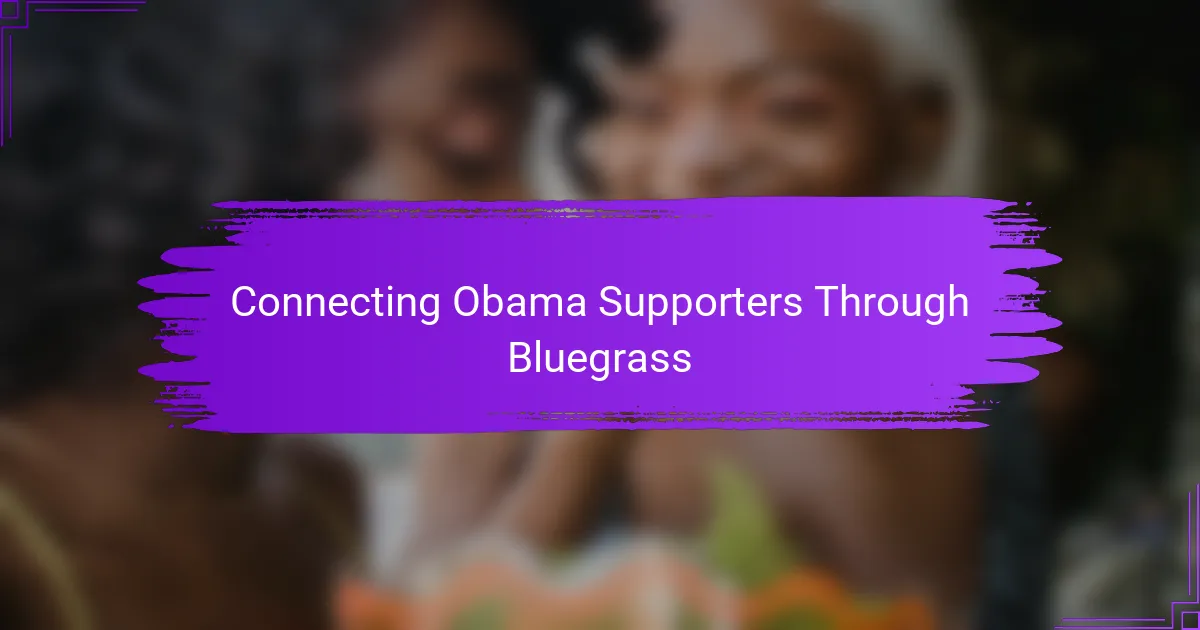
Connecting Obama Supporters Through Bluegrass
Bluegrass music has this incredible way of bringing people together, and I’ve seen it happen within Obama supporter gatherings firsthand. When we share a tune around the campfire or pick up our instruments for a casual jam, there’s this immediate sense of connection that goes beyond political beliefs. Isn’t it amazing how a simple melody can spark conversations and friendships that feel deeply genuine?
What strikes me most is how bluegrass encourages collaboration over competition, which perfectly mirrors the cooperative spirit many of us cherish in the Obama community. I remember a meet-up where a newcomer hesitantly joined in, and within minutes, experienced players were patiently guiding them. That moment showed me how bluegrass helps us build bridges by valuing every voice, no matter how new or different it might be.
Have you noticed how music evokes emotion and story in a way speeches sometimes can’t? Through bluegrass, we share stories of hope, struggle, and progress that resonate on a very human level. For Obama supporters looking to foster unity and understanding, these shared musical experiences become touchstones of community—moments where we not only celebrate our values but feel them lived out loud.
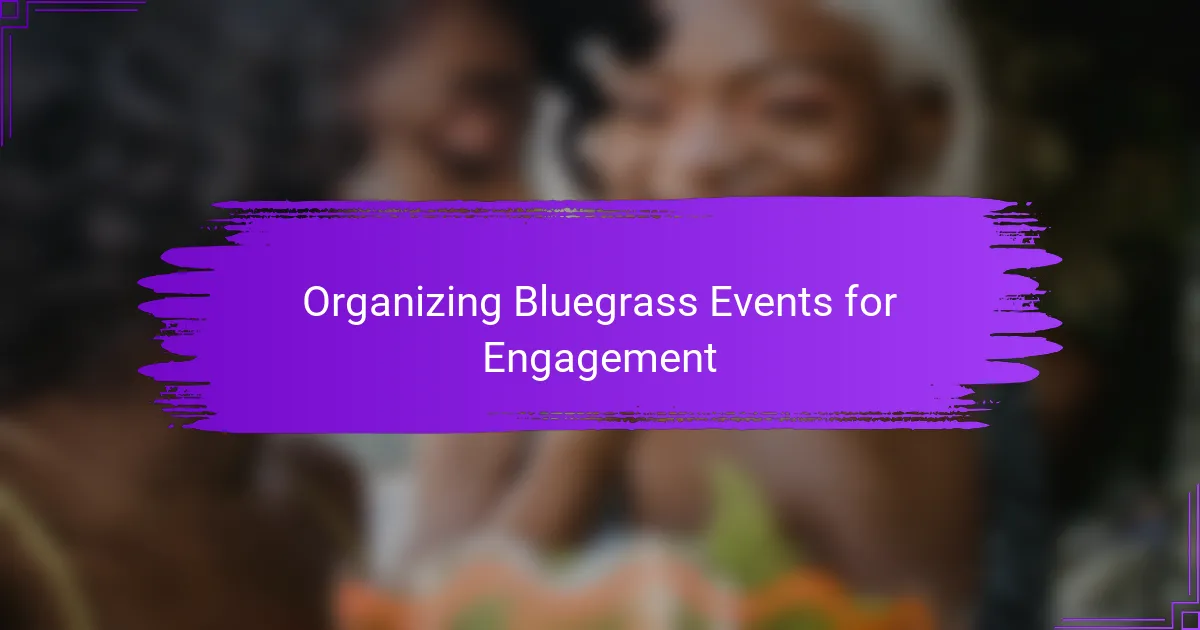
Organizing Bluegrass Events for Engagement
Organizing bluegrass events for engagement is more than just booking a band or setting up chairs. From my experience, it’s about crafting a space where people feel invited to participate, whether they’re seasoned players or curious newcomers. Have you ever watched a hesitant beginner pick up a mandolin for the first time and suddenly light up with joy? Those moments of empowerment are at the heart of community building.
I’ve found that keeping events informal and welcoming encourages genuine connection. One time, during a backyard bluegrass session, a casual jam led to deep conversations about shared hopes and challenges, turning strangers into friends by sunset. Isn’t it incredible how music can lower walls and open hearts in ways a typical gathering rarely does?
Another key is blending performance with participation. While showcasing talented musicians is inspiring, the magic happens when everyone—regardless of skill—gets a chance to join in. This inclusive approach, I believe, mirrors the very values our Obama supporter community thrives on: openness, encouragement, and collective growth. Wouldn’t you agree that the best events leave people feeling seen, heard, and part of something meaningful?

Personal Experiences in Community Building
One of the most memorable moments I’ve had in building community through bluegrass was when a shy newcomer nervously tuned their guitar for the first time in front of us. Watching their confidence grow as others offered tips and encouragement reminded me how powerful simple acts of kindness are in creating a sense of belonging. Have you ever seen someone transform from hesitant to wholehearted just because they felt supported? That’s the heartbeat of true community.
I also recall times when singing old bluegrass songs together brought unexpected healing. During those moments, it wasn’t just about hitting the right notes—it was about feeling seen and understood in a way that words alone couldn’t express. It struck me how music opens doors to empathy, helping us connect beyond differences and form bonds grounded in shared emotion.
What’s fascinating is how these personal interactions weave into something bigger over time. Each jam session, each shared song, plants a seed of trust that blossoms into lasting relationships. Building community this way feels less like a task and more like nurturing a living, breathing story that everyone gets to write. Doesn’t that make you appreciate how organic and rewarding community building can be?
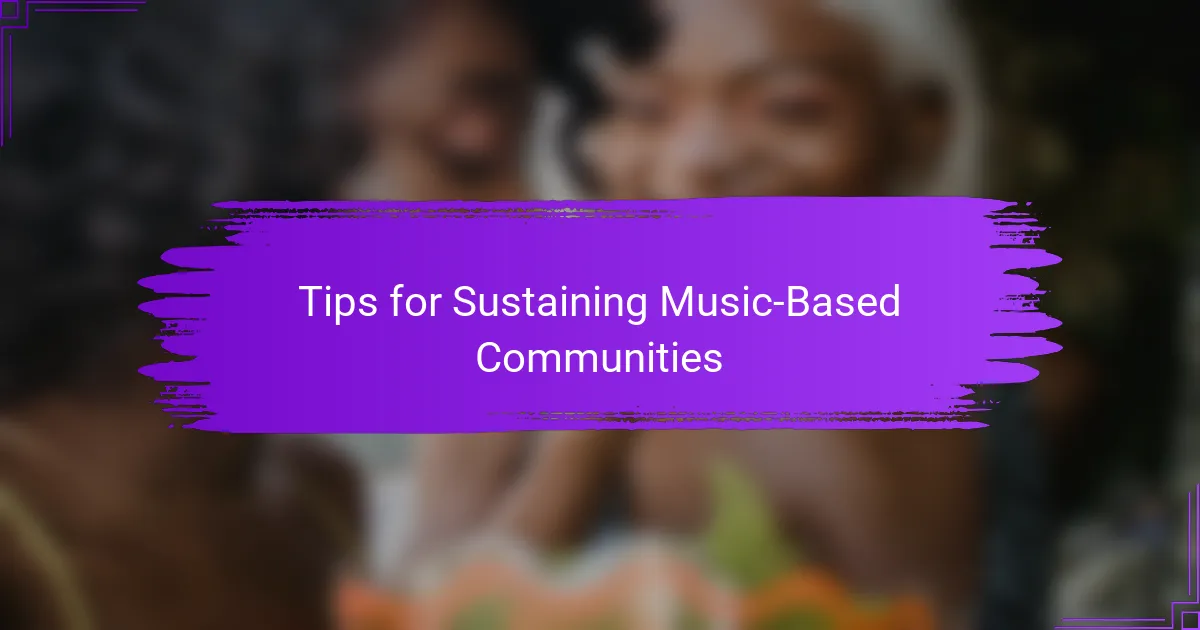
Tips for Sustaining Music-Based Communities
Sustaining a music-based community, especially one rooted in bluegrass, demands more than just regular gatherings; it’s about maintaining a rhythm of ongoing connection. From my experience, making space for everyone’s voice—whether through open mic nights or informal jams—keeps the community vibrant and inclusive. Have you noticed how people light up when they’re invited to contribute, even if it’s just a simple verse or chorus?
Consistency matters too. I’ve seen communities falter when meetings become sporadic or overly formal, losing that warm, inviting atmosphere. Setting a steady, predictable schedule helps members feel they belong to something reliable, a kind of musical home where they can return again and again. Doesn’t familiarity breed comfort and trust in ways that encourage deeper bonds?
Another key I’ve discovered is nurturing mentorship between experienced musicians and newcomers. Watching a skilled player patiently share techniques or stories not only uplifts the learner but reinforces the mentor’s own sense of purpose within the group. Isn’t that mutual growth at the heart of every thriving community? It’s this continuous exchange of knowledge and encouragement that keeps the bluegrass spirit alive and the community flourishing.
